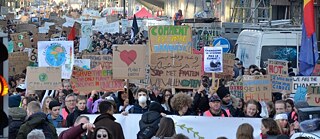On January 10th 2019, more than 2 years ago, over 3000 youngsters gathered in the streets of Brussels for the first school strike for climate. The whole country was startled by the amount of young people that were willing to skip school and go on the streets to strike for climate. One week later 15.000 students gathered in Brussels, and the week after the crowd grew to an amazing 35.000.
By Lola Segers
As a result of this gigantic success, it didn’t take long until the Belgian example was followed by other countries, and from then on school strikes were quickly adapted all over the world, and ‘youth for climate’ became a hot topic in the media.
A global movement was built, the media was finally covering the climate topic and even at the kitchen tables the topic was unavoidable. But the question that rises now is: What has actually changed since the start of this movement? How did the world react towards the demand of a system change and the need for a safe and secure future for generations to come?
A lot of pressure, created by millions of people
My involvement in the Belgian climate movement gave me the opportunity to indulge in an interesting conversation with Anuna De Wever, the founder of the climate movement in Belgium, and an intern in the EU parliament with the Greens/EFA group.The core message that I got out of my conversation with Anuna was largely about the fact that the school strikes and everything that came along with them, loosened up a lot of the debates, policies and legislations around climate change. The topic was finally put on the table instead of somewhere in a corner of the room and the world got to see how climate targets became more ambitious and how concrete measures were being taken. At last.
Europe’s promise for a sustainable future - The EU Green deal
What actually changed over the last 2 years is the fact that Ursula Von der Leyen, the president of the European Commission, made it very clear since day one that one of her main priorities would be the climate crisis. The Green Deal didn’t come long afterwards. It represented a set of different policies with the overarching goal of making Europe climate neutral by 2050. The Green Deal sounded very promising and seemed a step in the good direction.
The book cover without the book
As soon as the negotiations around the EU Green Deal started, it became unfortunately immediately very clear that it was only just the cover of a book, but the book wasn’t written yet. Quite some controversial statements were made during the negotiations about the different policies within the proposal. To give an example of this, one third of the EU budget for the next 7 years (MFF) will be going to the Common Agriculture Policy (CAP). Yet, this proposal will contribute to the loss in biodiversity and to an EU agriculture that is still heavily based on fossil fuels. Another example is how the EU is ratifying trade agreements like EU-Mercosur that would make us responsible for the destruction of the Amazon forest and the violation of indigenous rights. Along with this we also know that the current 2030 and 2050 targets are not based on science and neglect crucial warnings of the IPCC like possible feedback loops and tipping points. With the EU Green Deal we will be investing millions on trying to save the world, while spending billions on destroying it.
Change within our minds
The biggest change that has been made and is often forgotten about, is the change that happened in the minds of millions of people around the world. Our political leaders are beginning to understand the urgency and are making the solutions more concrete. The belief and faith in a better world and the demand for it are what will change it in the end. These changes are more important than ever before, since they allow a different way of thinking, outside of the current system. It doesn’t make sense to try and fix the world in a system that is already broken. Capitalism and the idea of eternal growth are at the basis of this crisis. Therefore, it is interesting to look at what the problem is with green capitalism and how that is also contributing to a world that we simply need to move away from to start building on a world that respects planetary boundaries and global equity. You can read more about this in the next blog.
